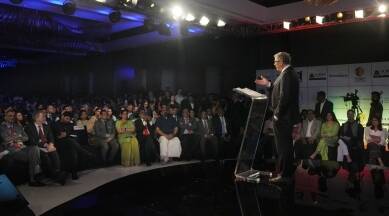Delivering the fifth Ramnath Goenka Memorial Lecture in New Delhi, Bill Gates, co-chair Bill and Melinda Gates Foundation, shared ideas on health systems, energy, climate change, and creating an equal world through innovation.
India’s 25-year development boom
Twenty-five years ago, I read a news article that changed the course of my life. On the front page of The New York Times, Nick Kristof explained how diarrhoea was killing three million people every year, over 90 per cent in lower-income countries.
It was 1997 and I had just had my first kid, Jenn. I worried about a lot of things when she was born, but nowhere on my list was a fear of her dying of diarrhoea or any infectious disease. And yet, that’s what millions of families were facing every day.
 Gates said that energy supply chains are under enormous strain because of the war in Ukraine. (Express photo by Praveen Khanna)
Gates said that energy supply chains are under enormous strain because of the war in Ukraine. (Express photo by Praveen Khanna)
This injustice — that the market wasn’t getting these life-saving tools to all of these kids and the chance of death in a poor country was 50 times higher than it was in the US – became the motivating force that I chose to work on as reduced my time at Microsoft when I went full time into the Bill & Melinda Gates Foundation in 2008… For the rest of my life, spending all my resources working on improving global health and reducing inequities.
 Bill Gates, philanthropist, tech founder, investor, and co-chair and Trustee of Bill and Melinda Gates Foundation, delivers the fifth Ramnath Goenka Memorial Lecture in New Delhi, Wednesday. (Express Photo by Renuka Puri)
Bill Gates, philanthropist, tech founder, investor, and co-chair and Trustee of Bill and Melinda Gates Foundation, delivers the fifth Ramnath Goenka Memorial Lecture in New Delhi, Wednesday. (Express Photo by Renuka Puri)
There has been a lot of progress since that 1997 article. For kids under five, deaths from the diarrheal disease have dropped by two-thirds. Strangely, there was a vaccine for the thing that caused over half of these diarrheal deaths. It’s called the rotavirus vaccine. But it was given to kids in the rich countries and not to the kids in other countries, who were most at risk of dying from that disease. Part of it was because it was not qualified, and part of it was that it was too expensive. And so, a group came together — a new entity called Gavi, the Gates Foundation and the Indian government — and pulled together the creation of a low-cost, high-volume vaccine. Eventually, 83 per cent of one-year-olds in India have now been inoculated against rotavirus, saving 200,000 children’s lives every year.
 Guests at the lecture (Express photo by Renuka Puri)
Guests at the lecture (Express photo by Renuka Puri)
India’s digital financial infrastructure enabled 80 per cent of Indians to be covered by bank accounts… elements of this digital infrastructure are now being exported
Globally, we have gone down from 10 million deaths a year to less than five million deaths of children under the age of five years. India has more progress than the global average. For example, the measles vaccine coverage wasn’t high in India till 2000. To get the coverage up, they gave the second dose. There was a miraculous improvement. From 114,000 deaths a year, it went down to below 5,000 — a 96 per cent reduction. The number of births assisted by health personnel went up from 43 per cent to 89 per cent today. The result was a 59 per cent drop in mothers’ mortality.
 Indian Express Executive Director Anant Goenka and Bill Gates at the Ramnath Goenka lecture.
Indian Express Executive Director Anant Goenka and Bill Gates at the Ramnath Goenka lecture.
Another example is empowering people, particularly women, with bank accounts, which our foundation helped support. In 2011, only 26 per cent of women had access to a bank account. That’s now 78 per cent. We still have more to do. But this is the fastest progress in any country. Behind that success are the digital stack and the great digital revolution that a lot of people in India drove, including the regulations. The government had to take some risks. But that has worked fantastically.
 Gates said, “In my lifetime I’ve never been so optimistic about the potential for new technologies to improve the world.” (Express Photo by Tashi Tobgyal)
Gates said, “In my lifetime I’ve never been so optimistic about the potential for new technologies to improve the world.” (Express Photo by Tashi Tobgyal)
The challenges
We faced huge challenges during the pandemic. Globally, over 20 million lives were lost and there was education loss and health system interruption. India, now, is back to vaccinating kids at pre-pandemic rates. But in countries in Africa, it is probably going to take us three years just to get back where we were.
 Bharat Biotech’s Krishna Ella (centre) with Anant Goenka. (Express photo by Tashi Tobgyal)
Bharat Biotech’s Krishna Ella (centre) with Anant Goenka. (Express photo by Tashi Tobgyal)
There is health: The first 25 weeks of the pandemic destroyed 25 years of progress in global health. Routine immunisation campaigns for other viruses were cancelled to maintain social distancing. And health systems bent, then broke, under the strain of the pandemic. It’s three years later, and most countries’ health systems are still not completely back on track.
 Indian Express Chief Editor Raj Kamal Jha with Bill Gates (Express photo by Renuka Puri)
Indian Express Chief Editor Raj Kamal Jha with Bill Gates (Express photo by Renuka Puri)
There is energy. Energy supply chains are under enormous strain because of the war in Ukraine. It’s leading to increased fuel and food prices in most parts of the world. The poorest get affected the most. If you look at poor farmers, they’re buying far less fertiliser, which will affect their yield for many years into the future. That drives malnutrition and ill health and is almost a poverty trap.
 Former Union Minister and BJP leader K J Alphons (left) at the lecture (Express photo by Tashi Tobgyal)
Former Union Minister and BJP leader K J Alphons (left) at the lecture (Express photo by Tashi Tobgyal)
Most of the carbon emissions come from rich countries and yet, most of the damage will be in middle- to lower-income countries that are near the equator. It is an incredible injustice
And there is climate. It gets worse every year. It is difficult to deal with that because modern economies are based on energy intensity. Over 80 per cent of that energy comes from burning hydrocarbon. Most of the emissions that cause this heating come from rich countries and yet, most of the damage will be in middle- to lower-income countries that are near the equator. It is an incredible injustice.
 The subject of the lecture was “Creating an Equal World: The Power of Innovation.” (Express Photo by Renuka Puri)
The subject of the lecture was “Creating an Equal World: The Power of Innovation.” (Express Photo by Renuka Puri)
The world is facing a limited time frame in which wealthy and middle-income countries can successfully step up and lead the green transition, to avoid the most drastic effects of climate change. We need to transition in all areas of life — manufacturing, transportation, agriculture, buildings and homes.
To do this will be one of the great industrial challenges of all time: to get the energy system to grow, be reliable and be green, without making the price go up, and actually making the price even lower than it is today. I call this the Green Premium.I remain an optimist. In our lifetime, human ingenuity and innovations have quite literally changed the world.
 Raghuram Rajan, Pranab Mukherjee, Ranjan Gogoi and S Jaishankar delivered the lecture in previous years.(Express Photo by Tashi Tobgyal)
Raghuram Rajan, Pranab Mukherjee, Ranjan Gogoi and S Jaishankar delivered the lecture in previous years.(Express Photo by Tashi Tobgyal)
I’ve been passionate about innovation since I was a teenager, writing computer code on a terminal at my high school.
But in my lifetime I’ve never been so optimistic about the potential for new technologies to improve the world.
I want to share some of those with you today, some of which are being developed here in India.
Health and diagnostics
COVID-19 set back progress in global health and the delivery of health services by years. But it also catalysed a new wave of health innovation, especially in the field of diagnostics in India and around the world, helping to increase testing capacity. And it has advanced self-testing and rapid disease detection, which has been game-changing.
When there are big outbreaks, one of the most important things public health officials need to do is get a sense of where the disease is — and where it’s spreading. They need that information in real-time. Right now, PCR tests are the gold standard for diagnostics in terms of accuracy, but they’re slow and expensive. At the height of the pandemic, Indian lab workers were working around the clock and putting themselves at risk of infection. That was so the whole country could process about two million PCR tests a day — which cost about $5 each.
 “Some of the focuses of our organisation are global health and inquities reduction,” said the Microsoft founder during the lecture. (Express Photo by Renuka Puri)
“Some of the focuses of our organisation are global health and inquities reduction,” said the Microsoft founder during the lecture. (Express Photo by Renuka Puri)
I am even more excited about the next generation of PCR testing. Just one of these new machines can process 150,000 tests per day. And you can even use one sample to test for different diseases at the same time. Imagine using one nasal swab to test a child for COVID, flu, and RSV, all for a fraction of the cost of current tests. More testing equals more diagnosing, which means more lives saved. New PCR tests aren’t the only new diagnostic technology.
An alternative to PCR tests are lateral-flow immunoassays — or Rapid Diagnostics Tests. If you’ve taken an at-home COVID-test lately, you’ve used one of these. The challenge here is that the world hasn’t updated how it manufactures these tests in decades. Pre-pandemic, the entire planet manufactured 3.5 billion tests a year. That’s for all diseases.
A new diagnostic technique which is under development, called reel-to-reel lamination, could manufacture 16 million test strips per day — or 5 billion per year. In the future, I’m hoping that this extreme volume of manufacturing will revolutionise medical care everywhere, including here in India.
 Gates spoke about Aadhaar and India’s digital networks and payment systems, while hailing the country’s reliable and low-cost connectivity.(Express Photo by Tashi Tobgyal)
Gates spoke about Aadhaar and India’s digital networks and payment systems, while hailing the country’s reliable and low-cost connectivity.(Express Photo by Tashi Tobgyal)
That’s because it would allow medical providers anywhere — from doctor’s offices in big cities to clinics in remote areas, to travelling health workers — to offer point-of-care diagnostics.
When backed by a scalable digital health platform, of the kind India is now building, we’re talking about being able to test for multiple diseases like TB, HIV or HPV anywhere, with basic swabs and no need for a specialised instrument.
Another thing is that we’ll look at sewage, which is called environment sampling, and we will see outbreaks far more rapidly than ever before.
 Co-chair and trustee of the Bill and Melinda Gates Foundation, Bill Gates took the stage weeks after the release of his latest book: How to Prevent the Next Pandemic. (Express Photo by Renuka Puri)
Co-chair and trustee of the Bill and Melinda Gates Foundation, Bill Gates took the stage weeks after the release of his latest book: How to Prevent the Next Pandemic. (Express Photo by Renuka Puri)
Climate mitigation and energy
Philanthropy makes up only two per cent of the spending in the US. Philanthropy is a solution to problems that government and private sector spending cannot go after. For example, in a disease like malaria, where the people affected don’t have the economic power and it’s not that attractive to make a vaccine or a new generation of drugs. There, philanthropy is very important. But when it comes to climate change, there isn’t nearly enough philanthropic funding — the two per cent is not enough to reinvent the industrial economy. We need to have price incentives and new innovative companies.
That requires government investments and market-based solutions. Lowering greenhouse gas emissions will require building new products, new companies, and even new industries. It requires innovation on a massive scale to create the technologies to eliminate the “green premium.” That means making things as cheap to produce without carbon… as it is to produce things with carbon.
 Gates underlined the power of innovation to bridge divides and the role of India in the “big, global innovation boom.” (Express Photo by Tashi Tobgyal)
Gates underlined the power of innovation to bridge divides and the role of India in the “big, global innovation boom.” (Express Photo by Tashi Tobgyal)
That’s the only way the world will get to net-zero emissions — if people and companies can transition without the penalty of higher prices for going green.
In 2015, when the Paris climate event was coming together, I was worried that the only topic of discussion was short-term metrics. It is good to have metrics. But this idea of getting innovation charged up was not on the agenda. I was able to have discussions with PM Modi and President Obama and other leaders and we put together five conferences called Mission Innovation in 2015. Eight years ago, I founded an organisation called Breakthrough Energy, specifically to raise private capital to take those ideas, fund start-ups and take those ideas into the market. Bringing in risk capital, IQ and acceleration of innovation. Usually, when we innovate, we don’t have a deadline. But in this case, we have a deadline to not only work on those ideas but deploy them in the markets. There a 100 companies that have been funded just because they have technologies that can help with the climate. Not all succeed. But it is really starting to happen.
 Bill Gates delivers the fifth Ramnath Goenka Memorial Lecture in New Delhi, Wednesday. (Express photpo by Renuka Puri)
Bill Gates delivers the fifth Ramnath Goenka Memorial Lecture in New Delhi, Wednesday. (Express photpo by Renuka Puri)
For example, some of our partners are developing new ways to manufacture carbon-intensive products such as steel and cement. Others are developing approaches to long-duration energy storage. They’re finding ways to store renewable sources of energy that are intermittent, like wind and solar. This way, they can generate power on demand — not just when the wind is blowing or the sun is shining.
Some of these clean-energy breakthroughs are happening right here in India. About 90 minutes away from here, in Rohtak, there is an entrepreneur named Vidyut Mohan, who is one of the fellows at Breakthrough Energy. His team is in the early stages of building a company named Takachar, which is developing the first portable biochar device for converting post-harvest crop and forest waste into valuable bioproducts. These include sustainable biofuels, fertilisers, and other chemicals.
This is a transformative device — it is an affordable solution that will allow even the most remote agricultural communities to transform waste and avoid burning their own debris, which causes billions of dollars in economic loss, significant air pollution, and increased wildfire risk. Additionally, these bioproducts create another economic stream for agricultural communities from what was once just harmful waste.
 ‘How to Prevent the Next Pandemic’ is a veritable action plan – informed by technology and the latest in vaccine research — to anticipate and address the next health challenge. (Express Photo by Renuka Puri)
‘How to Prevent the Next Pandemic’ is a veritable action plan – informed by technology and the latest in vaccine research — to anticipate and address the next health challenge. (Express Photo by Renuka Puri)
Climate adaptation and hunger
People are suffering from the effects of climate change right now. Sub-Saharan Africa accounts for only about four per cent of the world’s carbon emissions, but the region is bearing the brunt of climate change.
Climate-related losses on many African farms are more than double those seen globally. As a result, the continent will have 32 million more hungry people by the end of this decade. But that projection does not have to come true. And the reason is that there are new tools helping farmers adapt to climate change.
Some of the best innovation in crop research for climate adaptation is happening here in India. Just this morning, I visited the Indian Agricultural Research Institute (ICAR) in Pusa, a few kilometres away from here, where they are testing new crops, including chickpeas. Chickpeas are threatened by climate change. Higher temperatures could reduce yields by as much as 70 per cent. To prevent this from happening, the institute has been working with our foundation and other groups to produce new varieties. The results are still early. But in some cases, these plants are producing 10 per cent more chickpeas, plus are more drought resistant.
 “As the founder of The Indian Express, Ramnath Goenka institued some of the highest standards of journalism in India,” noted Gates. (Express Photo by Tashi Tobgyal)
“As the founder of The Indian Express, Ramnath Goenka institued some of the highest standards of journalism in India,” noted Gates. (Express Photo by Tashi Tobgyal)
India’s role in the global innovation boom
India’s role in this big, global innovation boom. India has 700 million young people and educational institutions that are getting stronger. We need innovation from the world but specifically, from India.

When I was at Microsoft, we chose to put a development centre here in 1998. And we did that because we knew India was going to play a major role in the global innovation ecosystem — not just as a beneficiary of new breakthroughs, but as an innovator of them. In addition as a scaler of breakthroughs.
India can develop high-quality yet cost-effective innovations and drive their rapid adoption. Vaccines are a prime example. I spoke about India’s rotavirus vaccines. Well, they aren’t just in India. Through Gavi, the Vaccine Alliance, they’re now being exported, saving hundreds of thousands of kids’ lives around the world. India’s role in earlier vaccine development made it very well-placed for producing the COVID vaccine as well — it was a global leader in manufacturing COVID-19 vaccines distributed all over the world. And there’s a well-known example, which is being highlighted during the present G20, of India’s digital public infrastructure. Aadhaar and financial empowerment have provided hundreds of millions of people with bank accounts, digital identities and payment services. We use it to pay health workers efficiently and it is used by farmers for loans to get the right fertiliser. The innovation on top of that digital platform is really just beginning. The Bank for International Settlements estimated that India’s digital financial infrastructure enabled 80 per cent of Indians to be covered by bank accounts in less than a decade, a feat that may have taken 47 years by traditional methods. Many elements of this digital infrastructure are now being exported to other countries too. This year, India is presiding over the G20. It convenes world leaders at a moment of great progress for India and great promise for the world. We are all looking to India — a place of innovation, ingenuity, and brilliant minds — to herald a new era of global partnership which can overcome the world’s greatest challenges.
https://indianexpress.com/article/india/bill-gates-india-is-not-just-a-beneficiary-of-new-breakthroughs-but-an-innovator-of-them-8476560/lite/














